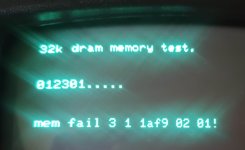I'm not sure what Dave will say, but I have found the white sockets on both my dynamic PET boards to be very good, but I have looked after them with lubrication.
One thing it pays to keep in mind; it is not a good idea to take IC's in and out of IC sockets over and over again without lubricating the sockets. If they are dry there can be significant wear. It doesn't take much lubricant, I do it by adding the lubrication (Inox's mx-3) to the IC's pins before they are plugged in and the lubricant transfers to the socket claws. This way you can take IC's in and out of the socket many times without damage to the socket. (mx-3 leaves a long lasting high purity oil behind and is better than any other product for this task)
If you want to check the socket claws, you can do it one by one on a test. It requires that a pin is removed from a dud IC and soldered to a small wire handle. You can also dip the pin in the lubricant. Then you pass it into the socket hole on the correct axis and you can feel the tension in the socket claws. Occasionally, a socket claw has been damaged by rough insertion of an IC, or somebody forcing pins in there that were thicker than those on an actual IC and you will be able to feel if the tension in the socket claw is lost.
Don't put any other kind of pin than an actual IC pin, or pin of identical geometry, into an IC socket, this includes the round pins on machine pin IC sockets. They stretch the socket claws apart and later they won't connect properly to an actual IC pin. If you are going to make any adapters for IC's, out of IC sockets, they must be made from the dual wipe type of socket, which has flat thin pins of the same geometry as an actual IC. Never make an adapter out of a machine pin socket, or the pcb socket you push that into, may not be suitable to take an IC again directly later.
It sounds like you need to stock up on some spare RAM IC's.

